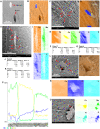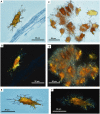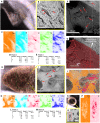In situ SEM/EDS compositional characterization of osteocytes and blood vessels in fossil and extant turtles on untreated bone surfaces; different preservational pathways microns away
- PMID: 32913685
- PMCID: PMC7456530
- DOI: 10.7717/peerj.9833
In situ SEM/EDS compositional characterization of osteocytes and blood vessels in fossil and extant turtles on untreated bone surfaces; different preservational pathways microns away
Abstract
Osteocytes and blood vessels are the main cellular and tissue components of the bone tissue of vertebrates. Evidence of these soft-tissue microstructures has been widely documented in the fossil record of Mesozoic and Cenozoic turtles. However, all these studies have characterized morphologically and elementally these microstructures via isolation from the fossilized bone matrix where they were preserved or in ground sections, which could raise skepticism about the results due to potential cross-contamination or reagents effects. Fossil turtle bones from three different localities with distinct preservation environments and geological settings, including Mongolemys elegans from the Late Cretaceous of Mongolia, Allaeochelys crassesculpta from the Eocene of Germany, and a podocnemidid indet. from the Miocene of Colombia are studied here. Bone from two extant turtle species, Lepidochelys olivacea, and Podocnemis lewyana, as well as a commercial chicken Gallus gallus were used for comparisons. Scanning Electron Microscopy-Energy Dispersive Spectroscopy analyses performed directly on untreated fresh surfaces show that osteocytes-like in the fossil turtle bone are mostly composed of iron and manganese. In contrast, the in situ blood vessels-like of the fossil turtles, as well as those from the extant taxa are rich in elements typically organic in origin (carbon and nitrogen), which are absent to minimally present in the surrounding bone or rock matrix; this suggests a possible endogenous composition for these fossil structures. Also, the results presented here show that although originally both (osteocytes and blood vessels) are organic soft components of bone as evidenced in the extant turtles and chicken, they can experience completely different preservational pathways only microns away from each other in the same fossil bone.
Keywords: Colombia; Deep time; Exceptional preservation; Germany; Osteoblasts; Fossil cells; Mongolia; Testudines.
©2020 Cadena.
Conflict of interest statement
The author declares that he has no competing interests.
Figures






Similar articles
-
Microscopical and elemental FESEM and Phenom ProX-SEM-EDS analysis of osteocyte- and blood vessel-like microstructures obtained from fossil vertebrates of the Eocene Messel Pit, Germany.PeerJ. 2016 Jan 21;4:e1618. doi: 10.7717/peerj.1618. eCollection 2016. PeerJ. 2016. PMID: 26819855 Free PMC article.
-
Variation in osteocytes morphology vs bone type in turtle shell and their exceptional preservation from the Jurassic to the present.Bone. 2012 Sep;51(3):614-20. doi: 10.1016/j.bone.2012.05.002. Epub 2012 May 11. Bone. 2012. PMID: 22584008
-
Caught in the act: the first record of copulating fossil vertebrates.Biol Lett. 2012 Oct 23;8(5):846-8. doi: 10.1098/rsbl.2012.0361. Epub 2012 Jun 20. Biol Lett. 2012. PMID: 22718955 Free PMC article.
-
'Fish' (Actinopterygii and Elasmobranchii) diversification patterns through deep time.Biol Rev Camb Philos Soc. 2016 Nov;91(4):950-981. doi: 10.1111/brv.12203. Epub 2015 Jun 23. Biol Rev Camb Philos Soc. 2016. PMID: 26105527 Review.
-
An overview of the South American fossil squamates.Anat Rec (Hoboken). 2014 Mar;297(3):349-68. doi: 10.1002/ar.22858. Epub 2014 Jan 31. Anat Rec (Hoboken). 2014. PMID: 24482358 Review.
Cited by
-
Raman Spectra and Ancient Life: Vibrational ID Profiles of Fossilized (Bone) Tissues.Int J Mol Sci. 2022 Sep 14;23(18):10689. doi: 10.3390/ijms231810689. Int J Mol Sci. 2022. PMID: 36142598 Free PMC article.
-
Nanoscopic imaging of ancient protein and vasculature offers insight into soft tissue and biomolecule fossilization.iScience. 2024 Jul 20;27(9):110538. doi: 10.1016/j.isci.2024.110538. eCollection 2024 Sep 20. iScience. 2024. PMID: 39286513 Free PMC article.
-
Soft Tissue and Biomolecular Preservation in Vertebrate Fossils from Glauconitic, Shallow Marine Sediments of the Hornerstown Formation, Edelman Fossil Park, New Jersey.Biology (Basel). 2022 Aug 2;11(8):1161. doi: 10.3390/biology11081161. Biology (Basel). 2022. PMID: 36009787 Free PMC article.
-
Report of bioerosions and cells in Cainotheriidae (Mammalia, Artiodactyla) from the phosphorites of Quercy (SW France).Sci Rep. 2024 Oct 10;14(1):23708. doi: 10.1038/s41598-024-74301-y. Sci Rep. 2024. PMID: 39390074 Free PMC article.
-
Pulmonary arteries in coelacanths shed light on the vasculature evolution of air-breathing organs in vertebrates.Sci Rep. 2024 May 9;14(1):10624. doi: 10.1038/s41598-024-61065-8. Sci Rep. 2024. PMID: 38724555 Free PMC article.
References
-
- Boskey AL, Gehron PR. The composition of bone. In: Rosen CJ, editor. Primer on the metabolic bone diseases and disorders of mineral metabolism. John Wiley & Sons Inc.; Washington, D.C.: 2013. pp. 49–58.
LinkOut - more resources
Full Text Sources

